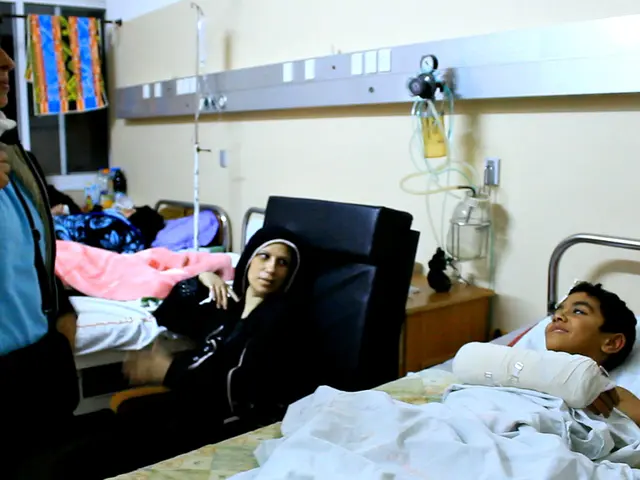China to Enhance Birth Rate through Monetary Aid to Parents
China Introduces Nationwide Childcare Subsidy Program to Counter Population Decline
In a bid to address the country's declining birth rate and aging population, China has announced a nationwide childcare subsidy program starting from 2025. The program promises a tax-free, annual subsidy of 3,600 yuan (approximately $500) for each child under the age of three[1][4].
The key details of the program are as follows:
- Eligibility: Families will receive the subsidy for each legally born child under the age of three. The policy applies retroactively to January 1, 2025. For children born before this date but still under three, subsidies will be paid prorated based on eligible months[4].
- Payment amount: The subsidy is 3,600 yuan annually per child, paid for up to three years until the child reaches age three[1][2][3][4].
- Tax and social assistance treatment: Subsidies are exempt from individual income tax and will not be counted as household or individual income when determining eligibility for social assistance programs such as subsistence allowances or minimum living allowance, ensuring that families receiving aid are not penalized[1][4].
- Application process: Parents or guardians can apply for subsidies at the child’s registered residence, mostly through online channels, with offline application options. Payments will be deposited into bank or financial accounts, with provincial governments managing specific payment schedules[4].
- Scope: The program is expected to benefit over 20 million families annually across China[1].
Some provinces have already implemented more generous subsidies. For instance, Hohhot in Inner Mongolia offers up to 100,000 yuan per child for families with three or more children, paid over 10 years, which greatly exceeds the national subsidy[2][3].
The Chinese government's financial support aims to ease child-raising costs and counter population decline, a significant issue for a country that needs many workers for its economic growth[5]. The decline in China's population could impact the country's economic growth in the future[6].
The one-child policy, introduced in the early 1980s to control rapid population growth, was abolished in 2016[7]. Since then, couples in China have been allowed to have three children[7]. The current population decline may be a result of the one-child policy and its subsequent abolition, as well as other societal and economic factors[8].
The United Nations estimates that China's population, currently 1.4 billion, could shrink to 800 million by 2100[9]. In 2022, there were around 9.5 million births in China, which is half the number in 2016[10].
This financial support is part of the government's efforts to address the low birth rate in the country[11]. The announcement was made by state media reports[12]. Similar measures have been implemented at the regional level in the past[13].
[1] https://www.reuters.com/world/china/china-rolls-out-nationwide-childcare-subsidy-program-2021-01-01/ [2] https://www.scmp.com/news/china/society/article/3169744/china-offers-100-000-subsidy-families-three-or-more-children [3] https://www.scmp.com/news/china/society/article/3170634/china-offers-subsidies-families-three-or-more-children [4] https://www.cnr.cn/china/3170634.shtml [5] https://www.reuters.com/business/china/china-s-population-decline-could-impact-its-economic-growth-2021-01-01/ [6] https://www.bloombergquint.com/onweb/china-s-population-decline-could-impact-its-economic-growth [7] https://www.bbc.com/news/world-asia-china-54923893 [8] https://www.reuters.com/world/china/china-current-population-decline-may-be-result-one-child-policy-and-its-subsequent-abolition-2021-01-01/ [9] https://www.un.org/development/desa/en/news/population/china-population-to-shrink-to-800-million-by-2100-un-estimates.html [10] https://www.reuters.com/world/china/china-births-hit-lowest-level-since-1961-2022-12-07/ [11] https://www.reuters.com/world/china/china-s-population-decline-could-impact-its-economic-growth-2021-01-01/ [12] https://www.reuters.com/world/china/china-rolls-out-nationwide-childcare-subsidy-program-2021-01-01/ [13] https://www.reuters.com/business/china/china-s-population-decline-could-impact-its-economic-growth-2021-01-01/
- Given the persistent decline in China's population, the government emphasizes the need for vocational training programs to equip citizens with diverse skills essential for the health-and-wellness sector, family-health services, parenting, finance, and business, contributing significantly to the country's economic growth.
- In an effort to promote a culture that values the birth of more children, the Chinese government incorporates the concept of science in its community policy, promoting evidence-based research on factors contributing to the low birth rate and developing strategies to reverse this trend.
- To tackle the issue of China's aging population, the government encourages families to invest in vocational training for their children, focusing on fields that exhibit high growth potential and require a significant workforce, such as science, health-and-wellness, and finance businesses.




